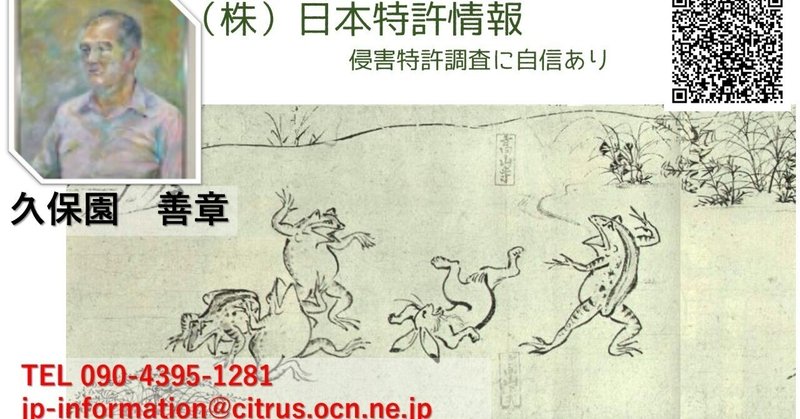
どうする特許庁! 目覚めよ審査官!! 不出来で、中途半端な「審査」(サーチ)による特許付与を、です。
知的財産高等裁判所により、「権利無効」とされたものの44件目です。
https://drive.google.com/file/d/1B-J6UW0yf_qshlEh0BbT9f-wh7Bm-vuo/view?usp=drive_link
特許権者である原告の日本精機株式会社他は、自分が保有する特許第4,094,831号(車両用監視装置)について、その特許の「有効性」を検証したか不明です。
「有効性」とは、自社の特許についての、例えば「無効資料調査」等を行うことで、たとえ利害関係者などの第三者からの「無効審判」を起こされても、自社の特許は盤石であると確信することです。
それにも拘らず、日本精機株式会社他は、特許庁より与えられた特許を有効と信じて、被告であるクラリオン株式会社を特許侵害している、と提訴しました。
先ず、東京地方裁判所は、「本件特許は,特許無効審判により無効にされるべきものである。したがって,原告らは,被告に対し本件特許権を行使することができない。」とし、原告の主張を退けました。
そして更に、知的財産高等裁判所は「本件各発明はいずれも特許無効審判により無効とされるべきものと認められ,控訴人らは,本件各発明に係る本件特許権に基づく権利を行使することはできない。」とし、結局、控訴人は敗訴しました。
その根拠として、「乙2」(実開昭61-146450)と「乙3」(特開2001-180401)の2件を先行技術文献として挙げています。
これら2件は、登録調査機関の検索者の清水幹夫は見つけることが出来なかった文献です。
検索者は上記の2件とは異なる文献を見つけてきて、これらを「X文献」として審査官に提示しました。
しかしながら、審査官は検索者からの提示文献では不十分と考え、自ら【検索論理式】を作成し、サーチを行って、先行技術文献を探しました。
その内の1件が、上記の「乙2」(実開昭61-146450)でした。
そして、これを含む3件に基づいて審査官は「拒絶理由通知書」を、そして「拒絶査定」を下しています。
出願人は、不服審判を申立て、審判に持ち込みました。ところが、審判官は「登録すべきもの」との裁定を下し、出願人はみごと特許権を得ました。
審査官が提示した3件では、強力なものとは審判官は考えなかったものと思います。
しかしながら、特許権者は東京地方裁判所と知的財産高等裁判所において、上記のように敗訴しました。
本件の根本原因は、東京地方裁判所で提示された「乙2」(実開昭61-146450)と「乙3」(特開2001-180401)の文献を、同時に探すことが出来なかったことに問題があると考えます。
登録調査機関の検索者及び審査官がこれら2件の「乙文献」を同時に見つけていさえすれば、と思います。
特許庁の審査官の指導のもとで行われる「サーチ」、その中の【検索論理式】の作成が正しく行われていない証拠と考えます。
この不十分で、中途半端な【検索論理式】の作成により得られた「先行技術調査」(サーチ)に基づいて判断し、そして特許査定により特許が付与してはいけません。
従って、本来なら、日本精機株式会社他の出願に対して、特許庁は特許を与えるべきでなかったと考えます。
ちなみに、この特許は「無効審判」により無効とされて消滅しました。
ここで、「乙2」(実開昭61-146450)の「出願情報」にある分類(「FI」と「Fターム」)をその公報の右欄に付します。
これと本件特許(特開2003-061086)の付与分類と比較して、共通(重複)するものにピンク色を付しました。
また、「乙3」(特開2001-180401)の「出願情報」にある分類(「FI」と「Fターム」)をその公報の右欄に付します。
これと本件特許(特開2003-061086)の付与分類と比較して、共通(重複)するものにもピンク色を付しました。
このことより、特許庁の審査官が何故この特許文献「乙3」(特開2001-180401)を探し当てることが出来なかったのか不思議でなりません。
特許庁の審査官は、所謂「サーチ」ではない、正しい「先行技術調査」を学び直す必要があると思います。
「行政」(特許庁)としては、「司法」(裁判所)により誤りを指摘されたことを謙虚に反省し、その誤りを正すことを心掛けるべきです。
特に、審査官が登録調査機関の検索者を指導して作らせている「検索論理式」、又は自らが作成していると思われる「検索論理式」の作成を、根本的に改革すべきです。
ここで、本件特許公開の「出願情報」のうち「FI」と「Fターム」を、本エクセル資料の2シート目以降に挙げておきました。
( Google Translation )
What will the patent office do! Wake up Judge! !
Granting a patent through poor and incomplete "examination" (search).
This is the 44th case in which the Intellectual Property High Court has determined that the rights are invalid.
It is unclear whether the patentee, the plaintiff Nippon Seiki Co., Ltd. and others have verified the "validity" of their patent No. 4,094,831 (vehicle monitoring device).
"Validity" means that even if a third party such as an interested party raises an "invalidation trial" by conducting, for example, an "invalid material investigation" for the company's patent, the company's patent is It is to be convinced that it is rock solid.
Despite this, Nippon Seiki Co., Ltd. and others sued Clarion Co., Ltd., the defendant, for patent infringement, believing that the patent granted by the Patent Office was valid.
First, the Tokyo District Court held that "the patent in question should be invalidated by a patent invalidation trial.
Therefore, the plaintiffs cannot exercise the patent right against the defendant." was dismissed.
In addition, the Intellectual Property High Court said, ``It was recognized that each of the Inventions should be invalidated by the trial for patent invalidation, and the appellants cannot exercise the rights based on the Patent Rights for the Inventions. can not be done.”, and the appellant lost.
As a basis for this, two documents, "Otsu 2" (Japanese Utility Model Laid-Open No. 61-146450) and "Otsu 3" (Japanese Unexamined Patent Publication No. 2001-180401), are cited as prior art documents.
These two documents were not found by Mikio Shimizu, the searcher of the registration search agency.
The searcher found documents different from the above two documents and presented them to the examiner as "X documents".
However, the examiner thought that the documents presented by the searcher were insufficient, so he created his own [search logical formula] and conducted a search to find prior art documents.
One of them was the above "Otsu 2" (Jitsukai 61-146450).
Based on these three cases, the examiner issued a "notification of reasons for refusal" and a "decision of refusal." The applicant filed an appeal and brought it to the appeal.
However, the trial judge ruled that it should be registered, and the applicant successfully obtained the patent right.
I don't think the trial judge considered the three cases presented by the examiner to be strong.
However, the patentee lost the lawsuit at the Tokyo District Court and the Intellectual Property High Court as described above.
The root cause of this case is that we were unable to simultaneously search for the documents of "Otsu 2" (Japanese Utility Model Laid-Open No. 61-146450) and "Otsu 3" (Japanese Unexamined Patent Publication No. 2001-180401) presented by the Tokyo District Court.
I think there is a problem. I hope that the searcher and examiner of the registered search agency find these two documents at the same time.
We consider this to be evidence that the "search" conducted under the guidance of an examiner at the Patent Office, and the preparation of the [search logic formula] in it, has not been performed correctly.
A patent should not be granted based on a "prior art search" (search) obtained by this inadequate and half-finished [search logic] formulation, and by grant of patent.
Therefore, I believe that the Patent Office should not have granted patents to the applications filed by Nippon Seiki Co., Ltd. and others.
By the way, this patent was invalidated by the "invalidation trial" and was extinguished.
Here, the classifications ("FI" and "F term") in the "application information" of "Otsu 2" (Japanese Utility Model Laid-Open No. 61-146450) are attached to the right column of the gazette.
In comparison with this and the assigned classification of the present patent (JP-A-2003-061086), common (overlapping) items are highlighted in pink.
In addition, the classification ("FI" and "F term") in the "application information" of "Otsu 3" (Japanese Patent Laid-Open No. 2001-180401) is attached to the right column of the publication.
In comparison with this and the assigned classification of the present patent (Japanese Unexamined Patent Application Publication No. 2003-061086), common (overlapping) items are also colored in pink.
This makes me wonder why the patent office examiner could not find this patent document "Otsu 3" (Japanese Patent Application Laid-Open No. 2001-180401).
I think that patent office examiners need to relearn correct "prior art searches" rather than so-called "searches." As the “administration” (the Patent Office), we should humbly reflect on the fact that the “judicial” (the court) pointed out the error, and should try to correct the error.
In particular, the creation of the "search logic formula" that the examiner instructs the searchers of the registered search organization to create, or the "search logic formula" that is considered to be created by themselves should be fundamentally reformed. is.
Here, "FI" and "F term" in the "application information" of this patent publication are listed from the second sheet onwards of this Excel document.
(Google 翻译)
专利局会做什么! 法官醒醒吧! !
通过糟糕且不完整的“审查”(检索)授予专利。
这是知识产权高等法院判定该权利无效的第44起案件。
目前尚不清楚专利权人、原告日本精机株式会社等人是否验证了其第4,094,831号专利(车辆监控装置)的“有效性”。
“有效”是指即使利害关系人等第三方通过对公司的专利进行“无效材料调查”等方式提出“无效审判”,该公司的专利仍应被确信是坚如磐石。
尽管如此,日本精机株式会社等仍以专利局授予的专利有效为由,起诉被告歌乐株式会社侵犯专利权。
首先,东京地方法院认为“涉案专利应当通过专利无效审判宣告无效。
因此,原告不能针对被告行使专利权。
”被驳回。 此外,知识产权高等法院表示,“经专利无效审理,各发明均应宣告无效,上诉人不能基于该发明的专利权行使权利。”
”,上诉人败诉 作为其基础,引用两个文献“Otsu 2”(日本实用新型公开No.61-146450)和“Otsu 3”(日本未审专利公开No.2001-180401)作为现有技术文献。
注册检索机构的检索员清水干雄并未找到这两份文件。
检索员发现了与上述两篇文档不同的文档,并将其作为“X文档”提交给审查员。
但审查员认为检索员提供的文献不够充分,于是他创建了自己的【检索逻辑公式】并进行检索以查找现有技术文献。
其中之一就是上面的“Otsu 2”(Jitsukai 61-146450)。
审查员根据这三起案件,发出了《驳回理由通知书》和《驳回决定书》。
申请人提出上诉,并提起上诉。
但初审法官裁定应当注册,申请人顺利取得专利权。
我认为主审法官认为审查员提出的三个案例并不有力。
但如上所述,专利权人在东京地方法院和知识产权高等法院败诉。
本案的根本原因是我们无法同时检索“Otsu 2”(日本实用新型公开号61-146450)和“Otsu 3”(日本未审查专利公开号2001-180401)的文献)东京地方法院提出的,我认为有问题。
我希望注册检索机构的检索员和审查员能够同时找到这两份文件。
我们认为这证明在专利局审查员的指导下进行的“检索”以及其中的[检索逻辑公式]的准备没有正确进行。
不应根据通过这种不充分且半成品的[检索逻辑]表述获得的“现有技术检索”(检索)以及授予专利来授予专利。
因此,笔者认为,专利局不应该对日本精机株式会社等人提出的申请授予专利权。
顺便说一句,该专利通过“无效审判”被宣告无效,并被消灭。
这里,“Otsu 2”(日本实用新型公开No.61-146450)的“申请信息”中的分类(“FI”和“F项”)被附在公报的右栏。
与本专利(JP-A-2003-061086)的指定分类相比,共同(重叠)的项目以粉红色突出显示。
另外,“Otsu 3”(日本特开2001-180401号公报)的“申请信息”中的分类(“FI”和“F术语”)被附在该出版物的右栏中。
与此和本专利(日本未审查专利申请公开No.2003-061086)的指定分类相比,共同(重叠)的项目也被着色为粉红色。
这让我想知道为什么专利局审查员找不到该专利文献“Otsu 3”(日本专利申请公开No.2001-180401)。
我认为专利局审查员需要重新学习正确的“现有技术检索”而不是所谓的“检索”。
作为“行政部门”(专利局),我们应该虚心反思“司法部门”(法院)指出的错误,并努力纠正错误。
特别是,审查员指示注册检索机构的检索人创建的“检索逻辑公式”的创建,或者被认为是由其自己创建的“检索逻辑公式”的创建应该从根本上进行改革。
这里,该专利公开的“申请信息”中的“FI”和“F术语”从该Excel文档的第二页开始列出。
この記事が気に入ったらサポートをしてみませんか?
